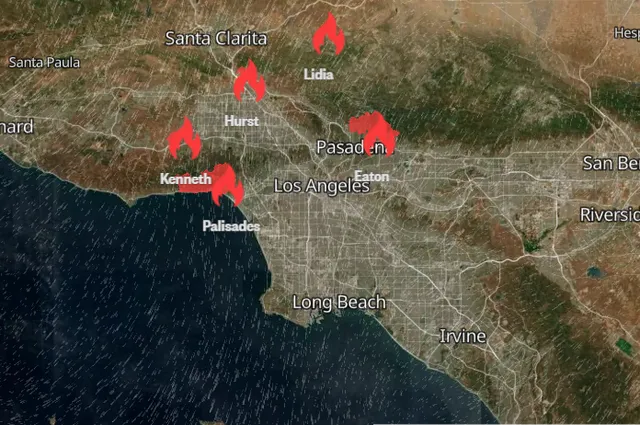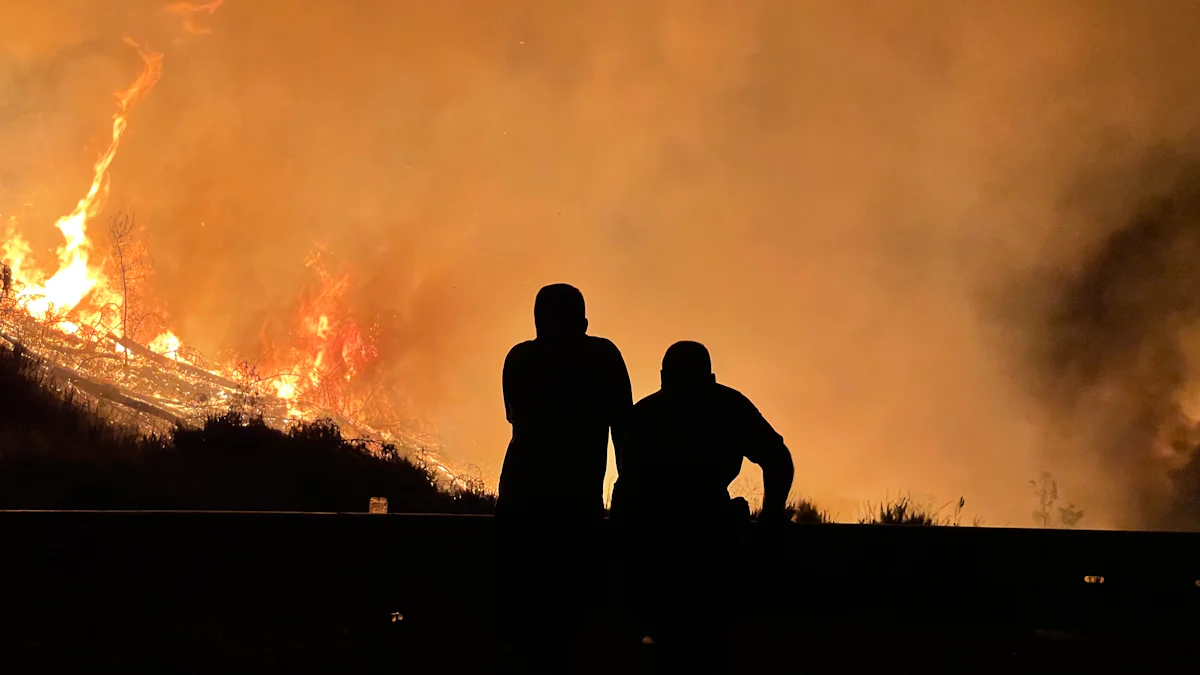Wildfires in Los Angeles Cause Major Transportation Delays

Wildfires in Los Angeles have reached an alarming scale, creating widespread disruptions across the region. The Palisades fire alone has burned over 17,000 acres, displacing upwards of 175,000 people and claiming at least five lives. Major highways, including I-210 and I-5, remain closed, halting critical transport routes. Freight companies face delays as rerouting increases transit times, disrupting logistics operations. These fires, fueled by dry vegetation and prolonged droughts in California, highlight the growing vulnerability of infrastructure. Los Angeles wildfires continue to challenge daily life, with significant impacts on transportation, businesses, and emergency services.
Key Takeaways
Wildfires in Los Angeles have shut down important roads, causing traffic problems.
Delivery trucks and freight services are delayed because of closed roads.
Planning ahead and using live updates can help during these times.
Building stronger roads and systems can reduce wildfire problems and keep people safe.
The Escalating Crisis of Wildfires in Los Angeles

Recent Wildfires and Their Devastating Impact
Los Angeles has faced some of the most severe wildfires in its history. The Palisades wildfire, which began on January 7, burned over 17,000 acres and forced 30,000 residents to evacuate. The Eaton wildfire, starting the same day, scorched 10,600 acres and led to 52,000 mandatory evacuations. These fire incidents destroyed thousands of structures, leaving communities devastated. The Hurst wildfire, though smaller in scale, added to the strain on emergency services.
Over the past decade, the frequency and severity of wildfires in Los Angeles have increased dramatically. Between 2009 and 2018, the region experienced 3,356 wildfires, burning over 7 million acres. This marks a sharp rise compared to previous decades, reflecting the growing wildfire risk in fire-prone areas. The wildfire crisis has disrupted logistics, displaced families, and caused billions in damages.
Environmental and Climatic Factors Fueling Wildfires
Environmental conditions in Southern California have created a perfect storm for wildfires. Prolonged droughts, fueled by climate change, have left vegetation dry and highly flammable. Rising temperatures, combined with shifts in precipitation patterns, have intensified the wildfire risk. Southern California endured an exceptionally hot summer, followed by a lack of fall and winter rains. This dry spell left the landscape parched and ready to ignite.
Additionally, strong winds, such as the Santa Ana winds, exacerbate fire outbreaks by spreading flames rapidly. Overgrowth of vegetation from previous years of above-average rainfall has also contributed to the problem. These factors, combined with human activity, have made California wildfires more frequent and destructive.
Health and Safety Concerns for Residents and Workers
Wildfires impact Southern California not only through destruction but also by degrading air quality. Smoke from wildfires contains harmful particles and toxins, posing serious health risks. Vulnerable groups, including children, older adults, and those with pre-existing conditions, face the highest risks. Research shows that wildfire smoke exposure can lead to respiratory failure, heart attacks, and strokes. Annually, over 2,000 deaths and 8,500 hospitalizations occur due to wildfire air pollution.
Workers in logistics and emergency services face additional challenges. Prolonged exposure to smoke increases the risk of long-term health issues, such as lung cancer and cardiovascular disease. The chemical composition of air pollution worsens when synthetic materials burn, further endangering health. Protecting residents and workers remains a critical priority during severe wildfires.
Transportation Disruptions from Wildfires Near Los Angeles

Road Closures and Traffic Gridlock
Wildfires near Los Angeles have caused widespread road closures and severe traffic congestion. Major highways, including I-210, I-5, and I-10, remain closed in key areas, disrupting daily commutes and logistics operations. For instance, I-210 near Roxford Street and I-10 westbound near Lincoln Boulevard have been shut down due to fire damage and safety concerns. Additionally, Pacific Coast Highway (CA-1) between Malibu and Santa Monica has been affected, further complicating transit routes.
Evacuation orders for tens of thousands of residents have intensified traffic gridlock. In the Pacific Palisades area, abandoned vehicles on narrow roads like Sunset Boulevard and Palisades Drive have worsened the situation. Smoke from the wildfires has reduced visibility, creating hazardous driving conditions and increasing transit delays. These disruptions highlight the challenges of maintaining mobility during such crises.
Highway | Location |
|---|---|
I-210 | Near Roxford Street |
I-5 | Connectors to I-210 |
I-10 | Westbound lanes near Lincoln Blvd |
CA-1 | Between Malibu and Santa Monica |
Freight and Delivery Delays
The wildfires have significantly impacted freight and delivery schedules in Los Angeles. Road closures and evacuation orders have delayed ground transportation, forcing carriers to reroute shipments. High winds and dry conditions have exacerbated the situation, making it difficult for freight companies to maintain regular operations. Deliveries within affected zones have faced delays, with postal and courier services struggling to navigate evacuation areas.
Logistics companies are actively monitoring the situation to minimize disruptions. However, the ongoing fires and smoke-related congestion have increased transit times. These delays not only affect local businesses but also disrupt supply chains across California. The economic damage from these interruptions underscores the importance of contingency planning in logistics operations.
Impacts on Air Travel and Airport Operations
While wildfires in Los Angeles have not significantly disrupted operations at major airports like LAX, regional flights have experienced delays. Smoke and high winds have reduced visibility, posing challenges for pilots and air traffic controllers. Travelers are advised to stay updated with their airlines for potential changes to flight schedules.
Authorities at LAX have reported minimal impact on flight operations. However, the situation remains fluid, and further escalation of the wildfires could lead to cancellations or additional delays. The resilience of airport infrastructure plays a crucial role in mitigating the damage caused by these natural disasters.
Logistics Challenges Stemming from Los Angeles Wildfires
Supply Chain Interruptions and Economic Costs
Wildfires in Los Angeles have caused severe supply chain disruptions, impacting the movement of goods and essential services. Road closures on major highways, such as the Pacific Coast Highway and Interstate 405, have halted truck transportation. Freight companies report delays as rerouted trucks face extended transit times. These disruptions strain supply chain networks, particularly for critical goods like food and medical supplies.
Damage to power infrastructure has left approximately 330,000 customers without electricity. This has disrupted production facilities and businesses reliant on consistent power. An unsafe water alert has further complicated operations, affecting industrial water supplies. Employee evacuations and transportation challenges have led to production stoppages in industries such as machinery and aerospace. The economic toll of these disruptions is significant, with ripple effects across California's logistics network.
Challenges for Emergency Response and Relief Efforts
Emergency response teams face numerous logistical challenges during wildfires. Strong Santa Ana winds, with gusts reaching up to 100 mph, hinder firefighting efforts. Rugged terrain in affected areas complicates access, delaying critical operations. Road closures disrupt transport routes, making it difficult to deliver supplies and evacuate residents.
Challenge | Description |
|---|---|
High Winds | Strong gusts hamper firefighting and evacuation efforts. |
Rugged Terrain | Difficult landscapes slow down emergency operations. |
Logistical Disruptions | Road closures block critical transport routes. |
Communication Needs | Effective coordination is essential for managing evacuations and resource allocation. |
Efficient communication remains vital for emergency response teams. Coordinating evacuation plans and resource distribution ensures the safety of residents and workers. Addressing these logistical challenges is crucial for maintaining supply chain continuity during crises.
Effects on Local and Regional Businesses
The wildfires have disrupted businesses across Los Angeles and surrounding regions. Power outages have affected operations for companies dependent on electricity. The unsafe water alert has further strained industries requiring clean water for production. Transportation disruptions have delayed the movement of raw materials and finished goods, impacting logistics and production schedules.
Employee evacuations have forced temporary closures of businesses, particularly in sectors like manufacturing and aerospace. These disruptions highlight the wildfire risk to economic stability in the region. Local businesses face mounting losses, while regional supply chain networks struggle to recover from the ongoing crisis.
Solutions to Mitigate Wildfire-Related Transportation Issues
Alternative Routing and Contingency Planning
Alternative routing plays a critical role in minimizing transportation disruptions caused by wildfires. When major highways and roads are closed, logistics companies can implement pre-planned alternative routes to ensure the movement of goods. For example, freight carriers can use secondary roads or bypass routes to avoid affected areas. This approach reduces delays and maintains supply chain continuity.
Contingency planning further strengthens preparedness. Businesses can develop risk assessment tools to identify potential threats to transportation networks. These tools allow companies to proactively address disruptions before they escalate. AI and big data technologies also enhance contingency planning by analyzing historical data and predicting wildfire patterns. This information helps optimize routes and ensures efficient delivery operations.
Solution | Description |
|---|---|
Real-Time Tracking | Provides up-to-the-minute information on shipment locations, allowing businesses to monitor goods. |
Alternative Routing Options | Suggests and implements alternative paths when usual routes are blocked by wildfires. |
Risk Assessment Tools | Helps identify potential threats to supply chains for proactive disruption mitigation. |
Analyzes historical data to predict disruptions and optimize routes based on real-time conditions. |
Real-Time Tracking and Communication Tools
Real-time tracking systems provide critical updates during wildfire emergencies. These tools allow businesses to monitor shipments and adjust plans based on current conditions. For instance, GPS-enabled tracking devices can pinpoint the exact location of goods, ensuring transparency in logistics operations. This technology helps companies reroute shipments quickly when wildfires block primary roads.
Effective communication tools also play a vital role. Emergency response teams and logistics managers can use these tools to coordinate efforts and share updates. Mobile apps and cloud-based platforms enable real-time communication, ensuring that all stakeholders remain informed. This level of coordination minimizes delays and enhances safety for drivers and workers.
Strengthening Infrastructure for Resilience
Improving infrastructure can reduce the impact of wildfires on transportation systems. Using heat-resistant materials for roadways prevents damage during extreme heat. Reinforcing airports with stormwater improvements and drainage upgrades ensures continued operations during emergencies. Redundancy in transportation routes also enhances resilience. By creating multiple access points, authorities can maintain mobility even when primary routes are compromised.
Investing in resilient infrastructure benefits both local and regional communities. These upgrades protect critical transportation networks and support the economy during wildfire crises. Strengthened infrastructure ensures that logistics operations can continue with minimal disruptions, safeguarding the movement of essential goods.
Wildfires in Los Angeles pose a growing threat to transportation networks, disrupting supply chains and daily life. These disruptions can block roads and damage infrastructure, preventing the movement of goods and people for extended periods. Communities relying on public transportation face disproportionate challenges, while economic impacts ripple through local and global trade systems.
Proactive measures can mitigate these effects. Steps like real-time tracking, alternative routing, and risk assessment tools ensure supply chain continuity. Businesses should monitor fire conditions, centralize data, and conduct annual drills to prepare for emergencies. Building resilient infrastructure and preparedness plans remains essential for protecting communities and sustaining economic stability.
See Also
Unveiling JUSDA's Growth: Sustainable Logistics Efficiency Explained
Understanding Logistics Risk Trends and Their Impacts
Affordable Transportation Management: Your Budget's Reliable Ally
Navigating Supply Chain Challenges: Insights on Inflation
Get Prepared: Discovering New Transport Technologies for Supply Chains
